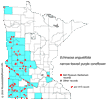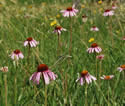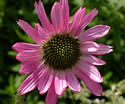Echinacea angustifolia (Narrow-leaved Purple Coneflower)
| Also known as: | Black-samson Echinacea |
|---|---|
| Genus: | Echinacea |
| Family: | Asteraceae (Aster) |
| Life cycle: | perennial |
| Origin: | native |
| Habitat: | sun; dry prairies |
| Bloom season: | June - October |
| Plant height: | 1 to 2 feet |
| Wetland Indicator Status: | none |
| MN county distribution (click map to enlarge): |  |
| National distribution (click map to enlarge): |  |
Pick an image for a larger view. See the glossary for icon descriptions.
Detailed Information
Flower: 
![[photo of flowers]](/udata/r9ndp23q/pd/echinacea-angustifolium-6-t.jpg) Flowers are single at the end of a stout hairy stem, with 15 to 20 pink to light purple rays (petals), each ¾ to 1½ inches long and ¼ to 1/3 inch wide, with 3 notched teeth at the tip. Rays grow out and up, drooping down and curving under with maturity. In the center is a large orangish brown disk, round to conical in shape, covered with small brown disk flowers with yellow pollen. A plant typically has 1 to a few flowering stems.
Flowers are single at the end of a stout hairy stem, with 15 to 20 pink to light purple rays (petals), each ¾ to 1½ inches long and ¼ to 1/3 inch wide, with 3 notched teeth at the tip. Rays grow out and up, drooping down and curving under with maturity. In the center is a large orangish brown disk, round to conical in shape, covered with small brown disk flowers with yellow pollen. A plant typically has 1 to a few flowering stems.
Leaves and stem: 


![[photo of leaves]](/udata/r9ndp23q/pink/echinacea-angustifolia-narrow-leaved-purple-coneflower_0710_134542-t.jpg) Leaves are mostly basal, with stem leaves widely spaced and alternately attached on the lower half of the stem. Lower leaves are long and narrow, to 8 inches long, ½ to 1 inch wide, on long stalks, becoming smaller and stalkless as they ascend the stem. Edges are toothless and there are 3 distinct veins along the length. Stems and leaves are hairy and rough to the touch. Stems may be green or purple tinged.
Leaves are mostly basal, with stem leaves widely spaced and alternately attached on the lower half of the stem. Lower leaves are long and narrow, to 8 inches long, ½ to 1 inch wide, on long stalks, becoming smaller and stalkless as they ascend the stem. Edges are toothless and there are 3 distinct veins along the length. Stems and leaves are hairy and rough to the touch. Stems may be green or purple tinged.
Notes:
A native of western sandy prairie, Narrow-leaved Purple Coneflower is not the species typically found in the nursery trade though native seed suppliers often offer it. Some references list this as a western variety of Echinaceae pallida (Pale Purple Coneflower), which has similar leaves but ray petals only about 1/8 inch wide and up to 3 inches long. E. purpurea (Eastern Purple Coneflower) has flowers similar to E. angustifolia but broader and shorter lanceolate leaves all the way up the stem. Of these 3 native coneflowers, only E. angustifolia is native to Minnesota but the other 2 grow well here and are commonly available in the native plant trade. An eastern variant from forest glades of central Tennessee can also be found in the wildflower trade as E. tennesseensis.
Native Plant Nurseries, Restoration and Landscaping Services ↓
More photos
 Narrow-leaved Purple Coneflower plant
Narrow-leaved Purple Coneflower plant Narrow-leaved Purple Coneflower habitat
Narrow-leaved Purple Coneflower habitat Tennessee Purple Coneflower, E. tennesseensis
Tennessee Purple Coneflower, E. tennesseensis
Photos by K. Chayka taken at Strandness Prairie, Pope County. Photos by Peter M. Dziuk taken in Pope County and in a private garden in Anoka County.
Comments
Have you seen this plant in Minnesota, or have any other comments about it?
on: 2013-07-14 11:20:50
Echinacea is present in many roadside prairie remnants in Douglas county. For more information on the ecology of Echinacea, see http://echinaceaproject.org/ I also saw a couple of Echinacea angustifolia plants in flower last week in a roadside prairie restoration near Hwy 10 and Main Street in Coon Rapids (Anoka county).
on: 2013-08-04 23:58:01
Saw large numbers of these along the roadside west of Bagley on Highway 2.
on: 2017-03-16 01:32:39
I have seen these in tree shelter open areas near old abandoned farm houses near my home. I have large patches of different varieties (originally of commercial source but lots of self seeding and interbreeding going on). Not sure if these are native species or less showy offspring from my gardens. Look like pictures. Not very exciting so have never looked at up close.






